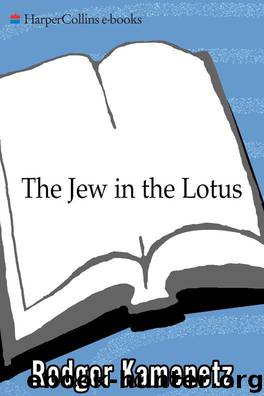Jew in the Lotus : A Poet's Rediscovery of Jewish Identity in Buddhist India by Rodger Kamenetz

Author:Rodger Kamenetz
Language: eng
Format: mobi
Tags: Buddhism
Published: 2011-06-23T07:05:12+00:00
13
Tibetan Intellectuals, Tibetan Orphans
SATURDAY, OCTOBER 27, KASHMIR COTTAGE
Saturday afternoon the Jewish delegation glimpsed the political tensions in the exile community. In the garden of Kashmir Cottage, we met with Lhasang Tsering, at that time president of the Tibetan Youth Congress (TYC), an organization that has played an opposition role in exile politics. In 1977 the group staged militant demonstrations at the Chinese embassy in New Delhi and made direct contacts with Indian political parties, which embarrassed the Kashag, or cabinet of the Dalai Lama. Since then, many TYC leaders have ended up working in the exile government’s bureaucracy, including Tsering. At times, then, the Dalai Lama has managed to coopt the potential rebellion, believing “that a militant attitude is helpful for maintaining morale among our youth, but a military movement itself is not feasible. It would be suicidal.”
When I met him, Lhasang Tsering appeared suave, sophisticated, very sharp in his sports jacket. A man in his mid-forties, he voiced his criticism of the government in mild terms. However, I could infer that greater political passion burned underneath. Later in 1990, after our meeting, he resigned from the TYC to pursue a more militant path of opposition. As an advocate of Tibetan independence, he has strongly criticized the Dalai Lama’s peaceful approach to negotiation. That afternoon he told us, “When people are restless and unhappy in this land—as they should be—the challenge to our leadership is how to lead them into something constructive.” Our friend, the monk and translator Laktor, replied that religious leaders faced a similar challenge. He admitted that westernized Tibetans in exile might get a feeling that “all this Buddhism is impractical” and added that “Buddhist education is confined to the monasteries, and we need to make it available to the people and let them judge if it is worthwhile or not. There is no need to change the truth but how to communicate it, so that other people can appreciate it.” I wondered whether the problem didn’t run deeper than packaging.
We did not discuss the situation in Tibet, but the problem of secularization is not confined to the exile. The Dalai Lama left Tibet in 1959, and an entire generation has grown up for whom he is a remote figure. And young Tibetans are not wholly isolated from popular culture, which has entered China through Taiwan and Hong Kong.
But the situation in the Tibetan and Jewish diaspora made for more immediate points of comparison. Like their American Jewish counterparts, Tibetan youth in India primarily attend public schools. Tsepak Rigzin, a translator for the library, told us, “Whether a nation survives depends on how well we preserve our tradition and culture. In Indian schools we are taught Tibetan one period a day for forty-five minutes. We blame the Indian educational system, but we ought to blame ourselves. We are allowed to teach in Tibetan but don’t.”
In response, several Jewish delegates praised Hebrew and Sunday School programs and offered them as a model. But Rabbi Levitt, a Sunday School principal herself, was less enthusiastic.
Download
This site does not store any files on its server. We only index and link to content provided by other sites. Please contact the content providers to delete copyright contents if any and email us, we'll remove relevant links or contents immediately.
Autoboyography by Christina Lauren(4684)
Asking the Right Questions: A Guide to Critical Thinking by M. Neil Browne & Stuart M. Keeley(4599)
Dialogue by Robert McKee(3593)
Eat That Frog! by Brian Tracy(3525)
Sticky Fingers by Joe Hagan(3456)
Journeys Out of the Body by Robert Monroe(2997)
Elements of Style 2017 by Richard De A'Morelli(2946)
Annapurna by Maurice Herzog(2847)
Schaum's Quick Guide to Writing Great Short Stories by Margaret Lucke(2808)
Full Circle by Michael Palin(2781)
The Diviners by Libba Bray(2447)
The Art of Dramatic Writing: Its Basis in the Creative Interpretation of Human Motives by Egri Lajos(2417)
The Mental Game of Writing: How to Overcome Obstacles, Stay Creative and Productive, and Free Your Mind for Success by James Scott Bell(2398)
Why I Write by George Orwell(2362)
Atlas Obscura by Joshua Foer(2351)
In Patagonia by Bruce Chatwin(2276)
The Fight by Norman Mailer(2160)
The Elements of Style by William Strunk and E. B. White(2077)
Venice by Jan Morris(2055)
